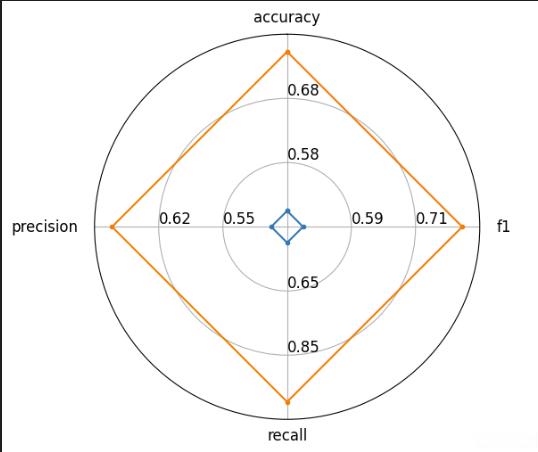hugging face基础入门——evaluate库的使用
创作时间:
作者:
@小白创作中心
hugging face基础入门——evaluate库的使用
引用
CSDN
1.
https://blog.csdn.net/weixin_56696781/article/details/144017236
内容前置
本系列下内容为跟随b站课程总结 课程链接:
【手把手带你实战HuggingFace Transformers】
本节内容主要是evaluate库的一些操作并修改之前编写的部分评估代码。
evaluate库的使用
首先我们可以通过下面方法查看evaluate支持的评估函数:
import evaluate
evaluate.list_evaluation_modules()
输出结果为
['Remeris/rouge_ru',
'hage2000/code_eval_stdio',
'lvwerra/test',
'jordyvl/ece',
'angelina-wang/directional_bias_amplification',
'cpllab/syntaxgym',
'lvwerra/bary_score',
'hack/test_metric',
'yzha/ctc_eval',
'codeparrot/apps_metric',
'mfumanelli/geometric_mean',
'daiyizheng/valid',
'erntkn/dice_coefficient',
'mgfrantz/roc_auc_macro',
'Vlasta/pr_auc',
'gorkaartola/metric_for_tp_fp_samples',
'idsedykh/metric',
'idsedykh/codebleu2',
'idsedykh/codebleu',
'idsedykh/megaglue',
'christopher/ndcg',
'Vertaix/vendiscore',
'GMFTBY/dailydialogevaluate',
'GMFTBY/dailydialog_evaluate',
'jzm-mailchimp/joshs_second_test_metric',
...
'lsy641/distinct',
'grepLeigh/perplexity',
'Charles95/element_count',
'Charles95/accuracy',
'Lucky28/honest']
这里我们加载下常用的accuracy看下
acc = evaluate.load("accuracy")
acc
输出结果为
EvaluationModule(name: "accuracy", module_type: "metric", features: {'predictions': Value(dtype='int32', id=None), 'references': Value(dtype='int32', id=None)}, usage: """
Args:
predictions (`list` of `int`): Predicted labels.
references (`list` of `int`): Ground truth labels.
normalize (`boolean`): If set to False, returns the number of correctly classified samples. Otherwise, returns the fraction of correctly classified samples. Defaults to True.
sample_weight (`list` of `float`): Sample weights Defaults to None.
Returns:
accuracy (`float` or `int`): Accuracy score. Minimum possible value is 0. Maximum possible value is 1.0, or the number of examples input, if `normalize` is set to `True`.. A higher score means higher accuracy.
Examples:
Example 1-A simple example
>>> accuracy_metric = evaluate.load("accuracy")
>>> results = accuracy_metric.compute(references=[0, 1, 2, 0, 1, 2], predictions=[0, 1, 1, 2, 1, 0])
>>> print(results)
{'accuracy': 0.5}
Example 2-The same as Example 1, except with `normalize` set to `False`.
>>> accuracy_metric = evaluate.load("accuracy")
>>> results = accuracy_metric.compute(references=[0, 1, 2, 0, 1, 2], predictions=[0, 1, 1, 2, 1, 0], normalize=False)
>>> print(results)
{'accuracy': 3.0}
Example 3-The same as Example 1, except with `sample_weight` set.
>>> accuracy_metric = evaluate.load("accuracy")
>>> results = accuracy_metric.compute(references=[0, 1, 2, 0, 1, 2], predictions=[0, 1, 1, 2, 1, 0], sample_weight=[0.5, 2, 0.7, 0.5, 9, 0.4])
>>> print(results)
{'accuracy': 0.8778625954198473}
""", stored examples: 0)
我们可以看到里面提供了具体参数及样例使用从而帮助我们理解。
但我们数据往往是逐步按批次处理的,那么我们就得奖代码改写为:
#流式数据处理
for pred,truth in zip([1,1,1,0,1],[1,0,1,1,1]):
acc.add(prediction=pred,reference=truth)
acc.compute()
#输出为{'accuracy': 0.6}
#批次数据处理
for batch_pre,batch_tru in [[[1,1,0],[1,0,0]],[[1,1,1],[0,1,0]]]:
print(batch_pre)
print(batch_tru)
acc.add_batch(predictions=batch_pre,references=batch_tru)
acc.compute()
#输出为[1, 1, 0]
# [1, 0, 0]
# [1, 1, 1]
# [0, 1, 0]
#{'accuracy': 0.5}
第一种方法(
acc.add(prediction=..., reference=...)
)更适合实时处理数据,逐步计算每个预测值和真实值的准确率。它可以在训练的每一个小批次中逐步更新结果。
第二种方法(
acc.add_batch(predictions=..., references=...)
)则更适合一次性处理一个批次的数据,通常在训练模型时会使用批量数据,因此这种方式更加高效,尤其是在计算多个样本的准确率时。
当我们需要使用多种评估函数时我们使用自带的combine函数:
combines = evaluate.combine(["accuracy","f1","recall","precision"])
combines_result_1 = combines.compute(predictions=[1,1,0,0],references=[1,0,1,0])
combines_result_1
输出为:
{'accuracy': 0.5, 'f1': 0.5, 'recall': 0.5, 'precision': 0.5}
为了更好理解模型之前性能区别,evaluate还提供了radar_plot函数为我们绘制雷达图,这里我随意据两个案例说明:
combines_result_1 = combines.compute(predictions=[1,1,0,0],references=[1,0,1,0])
#输出为{'accuracy': 0.5, 'f1': 0.5, 'recall': 0.5, 'precision': 0.5}
combines_result_2 = combines.compute(predictions=[1,1,1,0],references=[1,0,1,0])
#输出为{'accuracy': 0.75, 'f1': 0.8, 'recall': 1.0, 'precision': 0.6666666666666666}
from evaluate.visualization import radar_plot
data = [
combines_result_1,
combines_result_2
]
model_names = ["model1","model2"]
plot = radar_plot(data,model_names=model_names)
输出雷达图为:
原函数修改
学习了evaluate库之后,我们可以对hingingface基础入门——小模型全量微调-CSDN博客中评估函数进行修改并增加,原函数为:
def eval():
model.eval()
acc = 0
with torch.no_grad(): # 推理模式
for batch in validloader:

if torch.cuda.is_available():
batch = {k: v.cuda() for k, v in batch.items()}
output = model(**batch)
pred = torch.argmax(output.logits, dim=-1)
acc += (pred == batch["labels"]).float().sum().item() # 累计正确预测数
return acc / len(validset)
修改后函数为:
combines = evaluate.combine(["accuracy","f1"])
def eval():
model.eval()
acc = 0
with torch.no_grad(): # 推理模式
for batch in validloader:
if torch.cuda.is_available():
batch = {k: v.cuda() for k, v in batch.items()}
output = model(**batch)
pred = torch.argmax(output.logits, dim=-1)
combines.add(prediction==pred,reference=bath["labels"])
return combines.compute()
如有讲解不周到之初,欢迎指出交流,请大家多多包涵
热门推荐
如何区分直角、锐角和钝角?
最简单方便实现Ubuntu远程桌面的方法
患者体验与满意度:在线问诊系统的影响与反馈
如何选择黄金ETF或贵金属的投资方向?这种选择依据哪些市场条件和因素?
黄金ETF的结构如何影响投资成本?这种成本对投资者决策有何影响?
水边草本花卉有哪些
电池容量技术创新引领新能源汽车产业发展
公司辞退要怎么离职证明
信号发生器在电子设备浪涌测试中的应用
这种“三高”水果,我劝你多吃点
家庭与学校联手:青少年体质提升的关键在于共同努力
安卓如何关闭设备管理软件
房梁钉钉子影响风水吗
开盘15分钟走势分析:高开、低开、平开全解析
催吐对身体的危害:多久算频繁?真的能减肥吗?
雅马哈巧格i125省油?真实路测揭秘
冬季高发的慢性鼻炎,这些预防与护理技巧你做对了吗?
复读生的困境,2025年浙江高考复读限制深度剖析
解析典型传销案例特点分析报告:深层法律剖析与应对策略
夫妻口头协议有效吗
欠钱不还起诉指南:案由选择、诉讼费用与强制措施详解
网络工程师和运维工程师有什么区别
蝴蝶兰“爱吃”一种肥,每月“喂”一次,叶绿花又艳,花苞满枝头
物质结构与性质:金属晶体、离子晶体及过渡晶体详解
Nature重磅:AI帮助发现人体内天然减肥分子,媲美司美格鲁肽且无常见副作用
富兰克林的智慧:避免争辩,巧妙解决问题,发掘人性
Ubuntu进入root权限的三种方法
银行同业拆借业务的风险控制策略
企业间拆借资金怎样做才属合法
苹果树选址与土壤准备:为成功种植打下基础